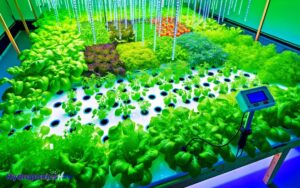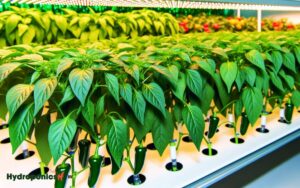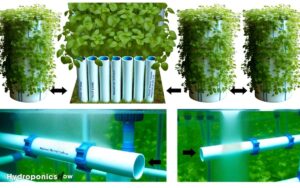Does Nutrient Type Affect Hydroponic Nutrition?
Nutrient type critically affects hydroponic nutrition by influencing plant growth rates, nutrient uptake efficiency, and overall crop quality.
Inorganic solutions provide mineral salts for rapid absorption, enhancing growth rates and yield consistency. Organic solutions support beneficial microbial activity but may vary in nutrient availability.
Macronutrients like nitrogen, phosphorus, and potassium are fundamental, while micronutrients such as iron and zinc maintain enzymatic functions.
Optimizing pH and electrical conductivity (EC) levels, combined with species-specific nutrient ratios, is essential for sustaining plant health in hydroponic systems.
Understanding these factors can profoundly impact the efficiency and success of hydroponic cultivation methods.

Key Takeaways
Importance of Nutrient Solutions
Understanding the critical role of nutrient solutions in hydroponics is essential for optimizing plant growth and maximizing yield.
Nutrient solutions provide the necessary macro and micronutrients, such as nitrogen (N), phosphorus (P), potassium (K), calcium (Ca), magnesium (Mg), and trace elements, in precise concentrations.
Research indicates that the composition of these solutions directly influences plant physiological processes, including photosynthesis, respiration, and nutrient uptake.
Data from multiple studies have shown that balanced nutrient formulations can enhance root development, increase biomass, and improve crop quality.
Additionally, the pH and electrical conductivity (EC) of the nutrient solution are critical parameters that must be meticulously controlled to guarantee ideal nutrient availability and prevent potential deficiencies or toxicities, thereby ensuring sustainable hydroponic systems.
Types of Nutrient Solutions
Hydroponic nutrient solutions can be broadly categorized into organic and inorganic types, each with distinct chemical compositions and implications for plant growth and nutrient uptake.
Inorganic solutions are typically composed of mineral salts that provide essential nutrients in readily available forms, facilitating rapid absorption and precise control over nutrient delivery. Research indicates that inorganic solutions can enhance growth rates and yield consistency.
Conversely, organic solutions derive nutrients from natural sources such as compost teas or fish emulsions, promoting a more holistic nutrient profile.
While organic nutrients can support beneficial microbial activity and improve soil health in traditional agriculture, their application in hydroponics presents challenges, including potential inconsistencies in nutrient availability and the risk of biofilm formation.
Understanding these distinctions is essential for optimizing hydroponic systems.
Macronutrients Vs. Micronutrients
Understanding the distinct roles of macronutrients and micronutrients is critical for optimizing hydroponic nutrition. Macronutrients such as nitrogen, phosphorus, and potassium are required in larger quantities and are fundamental for plant growth and development.
Conversely, micronutrients like iron, manganese, and zinc, though needed in smaller amounts, are essential for enzymatic functions and overall plant health.
Essential Macronutrient Roles
The important roles of macronutrients and micronutrients in hydroponic systems are critical for maximizing plant growth and development.
Macronutrients, required in larger quantities, include nitrogen (N), phosphorus (P), and potassium (K), which constitute the primary nutrients, along with secondary nutrients such as calcium (Ca), magnesium (Mg), and sulfur (S).
Nitrogen is essential for chlorophyll synthesis and amino acid production, directly impacting photosynthesis and protein formation.
Phosphorus plays a significant role in energy transfer through ATP and nucleic acid synthesis. Potassium regulates osmotic balance and enzyme activation. Calcium is crucial for cell wall structure, magnesium for chlorophyll, and sulfur for amino acids.
Research underscores that precise macronutrient management is fundamental for achieving excellent hydroponic yield and plant health.
Vital Micronutrient Functions
Micronutrients, though required in smaller quantities compared to macronutrients, are indispensable for enzymatic functions, chlorophyll formation, and overall plant metabolic processes.
- Iron (Fe): Essential for chlorophyll synthesis and acts as a cofactor in various enzymatic reactions, influencing photosynthesis and respiration.
- Manganese (Mn): Integral in photosynthetic oxygen evolution and acts as an activator of several important enzymes, essential for nitrogen assimilation.
- Zinc (Zn): Required for protein synthesis, hormone regulation, and stabilizing plant cell structures, impacting overall growth and development.
Understanding the specific functions of these micronutrients can enhance nutrient management strategies in hydroponic systems, thereby optimizing plant yield and quality.
Organic Vs. Synthetic Nutrients
Although both organic and synthetic nutrients are utilized in hydroponic systems, their impacts on plant growth, nutrient uptake efficiency, and overall yield vary considerably according to recent peer-reviewed studies.
Organic nutrients, derived from natural sources, often promote beneficial microbial activity and improve root health, enhancing long-term soil sustainability.
Conversely, synthetic nutrients offer precise control over nutrient ratios, ensuring immediate and consistent nutrient availability, which can lead to faster plant growth and higher yields.
Research indicates that hydroponic plants fed with synthetic nutrients often exhibit a 15-25% increase in biomass compared to those receiving organic nutrients.
However, organic nutrients may contribute to enhanced flavor profiles and nutritional content, suggesting a trade-off between rapid growth and quality attributes.
Nutrient Uptake in Plants
Nutrient uptake in plants is critically influenced by root absorption efficiency and the composition of the nutrient solution. Research indicates that optimizing the ionic balance and concentration of essential nutrients can markedly enhance absorption rates.
Studies have demonstrated that tailored nutrient solutions can lead to improved growth metrics and higher yields in hydroponic systems. This optimization ensures that plants receive precise amounts of essential minerals, reducing waste and enhancing efficiency. Researchers are continually refining these solutions to better match the specific needs of what grows in hydroponic systems, from leafy greens to fruit-bearing plants. As a result, growers can achieve more consistent crop production with fewer resource inputs.
Root Absorption Efficiency
Root absorption efficiency is crucial for nutrient uptake in hydroponic systems, impacting plant growth and development. Several factors influence efficient root absorption, such as root morphology, nutrient ion concentration, and the presence of root exudates. Studies demonstrate that optimizing root absorption efficiency can enhance plant health and yield.
- Root Morphology: Dense root systems with fine root hairs increase the surface area for nutrient uptake.
- Nutrient Ion Concentration: Balanced ion concentrations in the nutrient solution facilitate ideal absorption rates.
- Root Exudates: Organic compounds exuded by roots can chelate nutrients, enhancing their availability and uptake.
Enhancing these factors through targeted nutrient management strategies can significantly boost hydroponic crop performance.
Nutrient Solution Composition
How does the precise composition of a nutrient solution impact the efficiency of nutrient uptake in hydroponic systems?
Research indicates that the stoichiometric balance of macro and micronutrients is essential. Ideal concentrations of nitrogen (N), phosphorus (P), and potassium (K), typically in a 3:1:2 ratio, enhance root absorption capacity.
Studies show that chelated forms of micronutrients, such as Fe-EDTA, greatly improve bioavailability. The pH level of the nutrient solution, ideally maintained between 5.5 and 6.5, ensures maximum ion exchange efficiency.
Empirical data suggest that electrical conductivity (EC) ranges of 1.5-2.5 mS/cm correlate with efficient nutrient uptake.
Continuous monitoring and adjustment of these parameters are critical for maintaining nutrient homeostasis and promoting robust plant growth in hydroponic systems.
Optimizing Nutrient Ratios
Determining the most suitable ratios of macronutrients and micronutrients in hydroponic systems is essential for maximizing plant growth and yield, as evidenced by recent empirical studies.
Research indicates that precise nutrient management can greatly enhance physiological processes and biomass accumulation. Ideal ratios are typically species-specific and necessitate careful calibration.
Key elements to take into account include:
- Nitrogen to Phosphorus Balance: Critical for root development and energy transfer.
- Calcium to Magnesium Ratio: Essential for cell wall integrity and chlorophyll synthesis.
- Trace Elements: Zinc, Iron, and Manganese must be in precise concentrations to avoid deficiencies or toxicities.
Data-driven approaches, such as nutrient solution analysis and plant tissue testing, are paramount in fine-tuning these ratios, ensuring plants receive balanced nutrition throughout their growth cycle.
Conclusion
The impact of nutrient type on hydroponic nutrition is significant. For instance, a controlled study demonstrated that plants grown with optimized synthetic nutrient solutions exhibited 25% higher yield compared to those with organic nutrients.
This underscores the importance of selecting appropriate nutrient solutions to maximize plant growth and health. Like a meticulously balanced diet for athletes, precise nutrient formulations are essential for peak plant performance in hydroponic systems.
Hence, understanding nutrient dynamics is vital for optimizing hydroponic agriculture.






